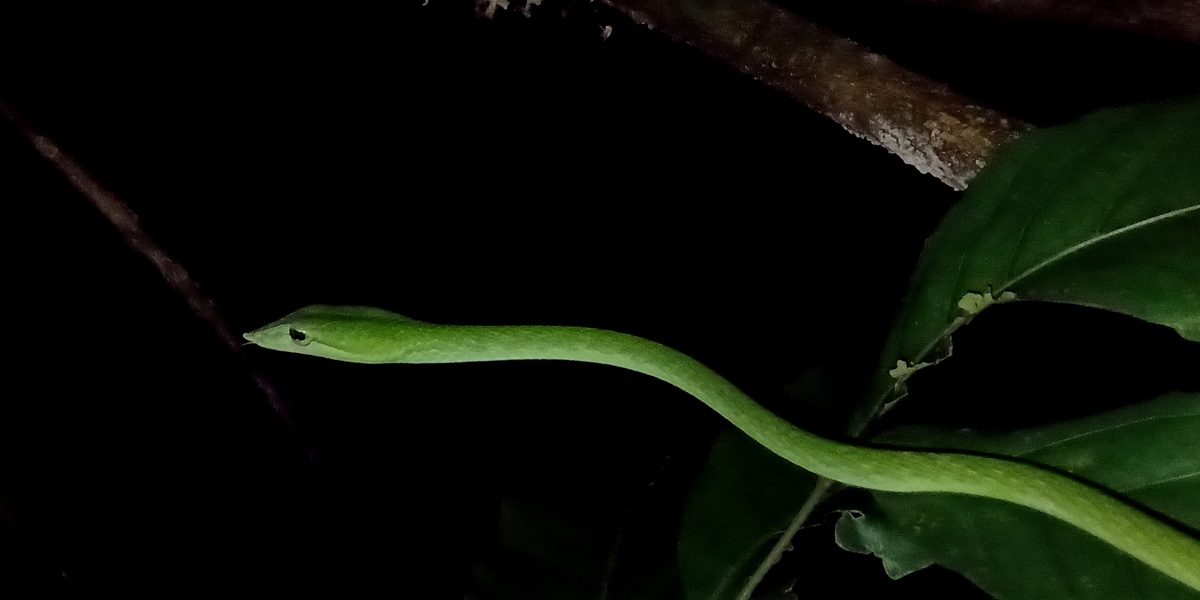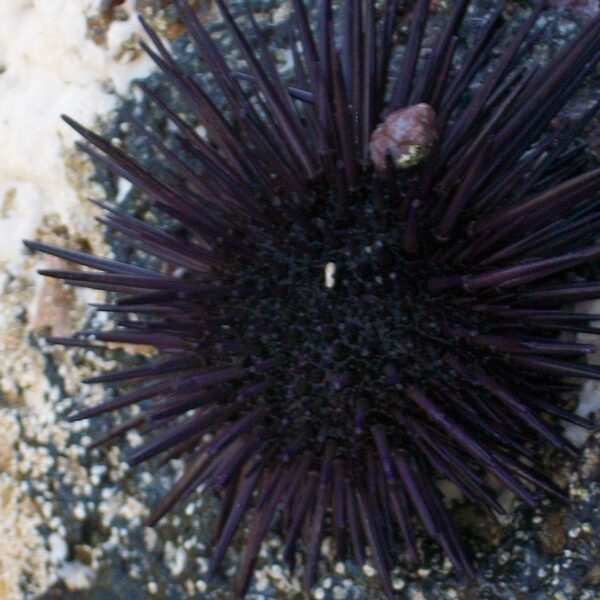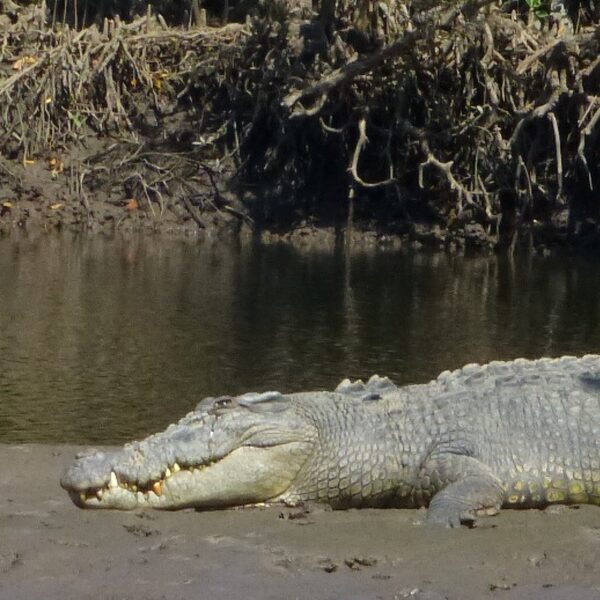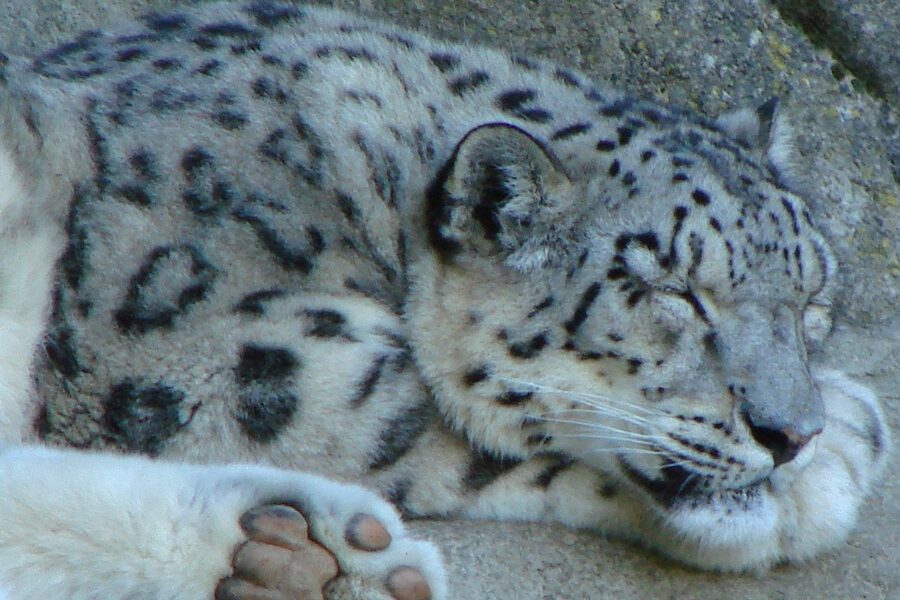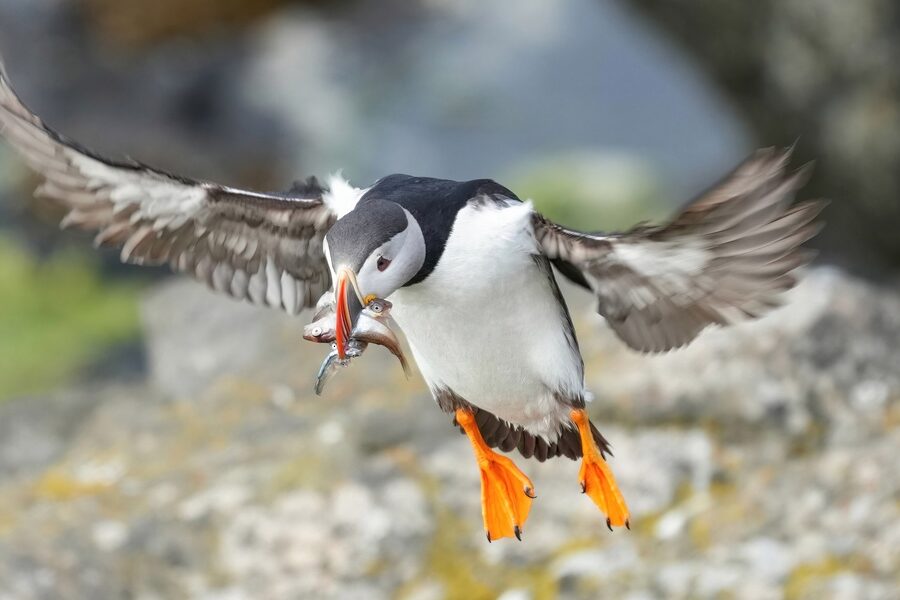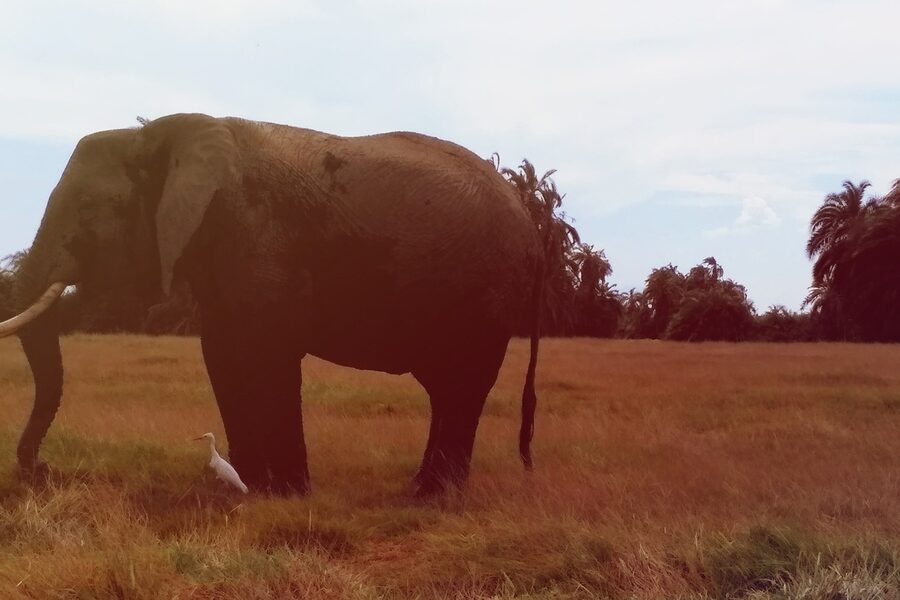There are 63 green snakes on this complete list. The list covers snakes from every continent with green species, from tiny meadow snakes to long vine snakes, arboreal racers, heavy constrictors, and highly venomous mambas and vipers. Many of these snakes live in trees and use bright green color as camouflage.
Scroll the list below to find each snake with its scientific name, range, and whether it is venomous.
Are green snakes venomous?
Green snakes vary in danger. Many are harmless non‑venomous species like rough and smooth green snakes, tree boas, and rat snakes. Some are rear‑fanged with mild venom that only affects small prey or causes minor reactions in people. A smaller number are highly venomous, including green mambas and several tree vipers. Check the “Venomous?” column to see risk at a glance. If you find a green snake, do not touch it. Give it space and call local wildlife or medical help if bitten.
Green Snakes
| Name | Scientific name | Range | Venomous? |
|---|---|---|---|
| Rough Green Snake | Opheodrys aestivus | Eastern North America | No |
| Smooth Green Snake | Opheodrys vernalis | Northern North America | No |
| Green Vine Snake | Ahaetulla nasuta (s.l.) | South & Southeast Asia | Mild (rear-fanged) |
| Parrot Snake | Leptophis ahaetulla | Central & South America | Rear-fanged (mild) |
| Mexican Parrot Snake | Leptophis mexicanus | Mexico to Central America | Rear-fanged (mild) |
| Speckled Parrot Snake | Leptophis punctatus | Central America | Rear-fanged (mild) |
| Brown-headed Parrot Snake | Leptophis spp. | Central/South America | Rear-fanged (mild) |
| Yucatan Parrot Snake | Leptophis spp. | Yucatán Peninsula | Rear-fanged (mild) |
| Western Parrot Snake | Leptophis spp. | Western Central America | Rear-fanged (mild) |
| Green Forest Racer | Dendrelaphis spp. | S. & SE Asia | No |
| Baron’s Green Racer | Philothamnus baroni | West/Central Africa | No |
| Amazon Green Racer | Philodryas aestiva | Amazon Basin | Rear-fanged (mild) |
| Green Rat Snake | Gonyosoma spp. | Southeast Asia | No |
| Red-tailed Green Ratsnake | Gonyosoma oxycephalum | Southeast Asia | No |
| Emerald Tree Boa | Corallus caninus | Amazon Basin | No |
| Green Anaconda | Eunectes murinus | Amazon & Orinoco basins | No |
| Eastern Green Mamba | Dendroaspis angusticeps | Coastal East Africa | Yes (potent) |
| Western Green Mamba | Dendroaspis viridis | West/Central Africa | Yes (potent) |
| Jameson’s Mamba | Dendroaspis jamesoni | Central Africa | Yes (potent) |
| Spotted Bush Snake | Philothamnus semivariegatus | Sub-Saharan Africa | No |
| Angolan Green Snake | Philothamnus angolensis | Southern Africa | No |
| Southern Green Snake | Philothamnus spp. | Southern Africa | No |
| African Green Water Snake | Genus Hydrophis/Grayia spp. | West & Central Africa rivers | No |
| Emerald Snake | Various spp. | Tropical regions | Varies |
| Lined Green Snake | Dendrelaphis punctulatus (complex) | Australia/SE Asia | No |
| Large-eyed Green Tree Snake | Dendrelaphis spp. | Southeast Asia | No |
| West African Green Bush Viper | Atheris chlorechis | West Africa | Yes (venomous) |
| Side-striped Palm Pit Viper | Bothriechis lateralis | Central America | Yes (venomous) |
| Yellow-blotched Palm Pit Viper | Bothriechis aurifer | Central America | Yes (venomous) |
| Black-speckled Palm Pit Viper | Bothriechis nigroviridis | Central America | Yes (venomous) |
| Guatemalan Palm Pit Viper | Bothriechis guifarroi | Guatemala | Yes (venomous) |
| Honduran Palm Pit Viper | Bothriechis spp. | Honduras | Yes (venomous) |
| Tzotzil Palm Pit Viper | Bothriechis tzotzilorum | Southern Mexico | Yes (venomous) |
| Merendon Palm Pit Viper | Bothriechis meridionalis | Central America | Yes (venomous) |
| Guifarro’s Palm Pit Viper | Bothriechis guifarroi | Honduras | Yes (venomous) |
| Oriental Whip Snake | Ahaetulla prasina | South & Southeast Asia | Mild (rear-fanged) |
| Malayan Green Whipsnake | Ahaetulla mycterizans | Southeast Asia | Mild (rear-fanged) |
| Indian Green Vine Snake | Ahaetulla nasuta/oxyrhyncha | India | Mild (rear-fanged) |
| Sri Lankan Green Vine Snake | Ahaetulla cf. fusca | Sri Lanka | Mild (rear-fanged) |
| Nilgiri Vine Snake | Ahaetulla beddomei | Southern India (Nilgiris) | Mild (rear-fanged) |
| Burmese Vine Snake | Ahaetulla fronticincta/parallelus | Myanmar region | Mild (rear-fanged) |
| Chinese Green Ratsnake | Ptyas major or Elaphe spp. | China & East Asia | No |
| Greater Green Snake | Cyclophiops major? /Ahaetulla spp. | Asia | No |
| Green Ratsnake | Gonyosoma/Elaphe spp. | Asia | No |
| Green Keelback | Rhabdophis spp. | Asia | Mild to moderate |
| Green Cat Snake | Boiga cyanea/Boiga spp. | Asia | Rear-fanged (mild) |
| White-lipped Pit Viper | Trimeresurus albolabris | Southeast Asia | Yes (venomous) |
| Chinese Green Pit Viper | Trimeresurus stejnegeri | East Asia | Yes (venomous) |
| Pope’s Pit Viper | Trimeresurus popeiorum | Southeast Asia | Yes (venomous) |
| Large-eyed Pit Viper | Trimeresurus macrops | Southeast Asia | Yes (venomous) |
| Beautiful Pit Viper | Trimeresurus pulcherrimus? /Trimeresurus venustus | Asia | Yes (venomous) |
| Ruby-eyed Pit Viper | Trimeresurus rubeus | Indochina | Yes (venomous) |
| Cameron Highlands Pit Viper | Tropidolaemus subannulatus? /Trimeresurus hageni | Malaysia | Yes (venomous) |
| Hainan Pit Viper | Trimeresurus hainanus | Hainan Island, China | Yes (venomous) |
| Sri Lankan Green Pit Viper | Trimeresurus trigonocephalus? /Trimeresurus purpureomaculatus? (regional) | Sri Lanka | Yes (venomous) |
| Bamboo Pit Viper | Trimeresurus gramineus | South & Southeast Asia | Yes (venomous) |
| Gumprecht’s Pit Viper | Trimeresurus gumprechti | Indochina | Yes (venomous) |
| Vogel’s Pit Viper | Trimeresurus vogeli | Southeast Asia | Yes (venomous) |
| Ornate Flying Snake | Chrysopelea ornata | Southeast Asia | Mild (rear-fanged) |
| Paradise Flying Snake | Chrysopelea paradisi | Southeast Asia | Mild (rear-fanged) |
| Sri Lankan Flying Snake | Chrysopelea taprobanica | Sri Lanka | Mild (rear-fanged) |
| Green Tree Python | Morelia viridis | New Guinea & Australia | No |
| Green Tree Snake | Dendrelaphis punctulatus /Morelia? (regionally variable) | Australasia/Asia | No |
Images and Descriptions
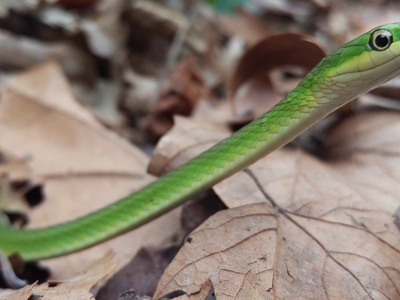
Rough Green Snake
A slender, bright-green tree and grassland snake that feeds on insects and small frogs. Timid and non-venomous; often seen in gardens and along streams. Adults reach about 60–100 cm and are excellent climbers.
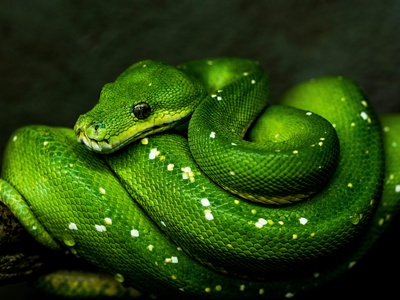
Smooth Green Snake
Small, smooth-scaled green snake found in grassy meadows and marsh edges. Harmless to people; mainly insectivorous. Typically 30–60 cm long and secretive, often overlooked due to its camouflage and quiet habits.
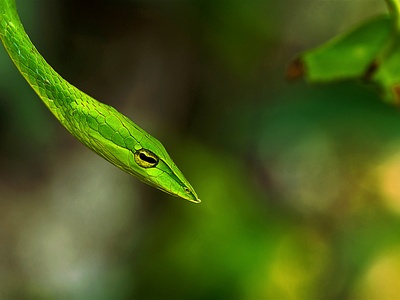
Green Vine Snake
A thin, elongated arboreal snake with a pointed snout and excellent camouflage among vines. Mildly venomous rear-fanged species complex; bites rarely serious to humans but used to subdue small prey.
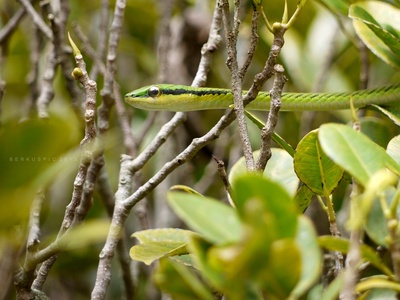
Parrot Snake
Slim, bright-green snake that hunts birds and frogs in trees. Fast and alert, generally non-threatening to people though rear-fanged and mildly venomous. Often mistaken for harmless green snakes.
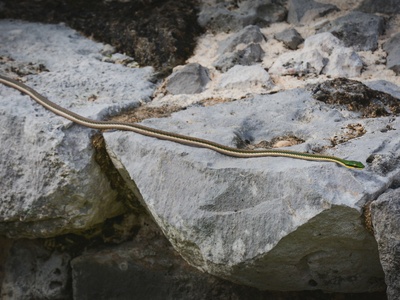
Mexican Parrot Snake
Arboreal, slender parrot snake found in tropical forests and edges. Diurnal hunter of lizards and frogs. Rear-fanged with mild venom; usually shy and avoids humans.

Speckled Parrot Snake
Green-bodied snake with speckling or patterning, living in lowland forests and secondary growth. Diurnal and agile, it preys on small vertebrates. Rear-fanged and not considered dangerous to people.
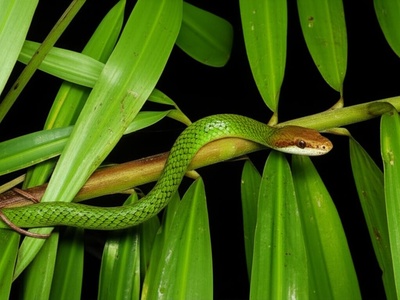
Brown-headed Parrot Snake
Green-bodied arboreal snake with a distinct brown head. Prefers forest canopy and edge habitats, feeding on lizards and frogs. Rear-fanged; generally not a human threat.
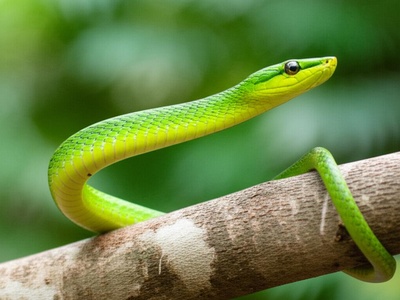
Yucatan Parrot Snake
A slender, green arboreal snake native to Yucatán forests and scrub. Diurnal predator of small vertebrates and typically avoids people; rear-fanged with mild venom.
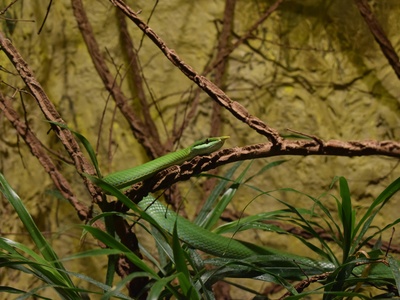
Western Parrot Snake
Tree-dwelling green snake common in humid forests and plantations. Fast-moving and alert; feeds on frogs, lizards, and birds. Mildly venomous rear-fanged species, rarely a hazard to humans.
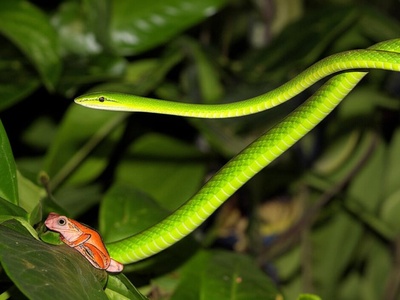
Green Forest Racer
Long, graceful arboreal snake that hunts by day in forest canopies. Non-venomous and fast-moving, it feeds on frogs, lizards and occasionally birds. Frequently mistaken for venomous species due to bright coloration.
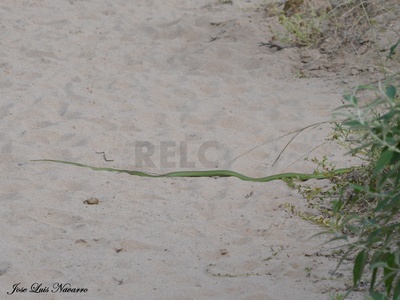
Baron’s Green Racer
Slim, bright-green tree snake found in woodlands and savanna trees. Diurnal and quick, feeding mainly on frogs and lizards. Harmless to humans and often seen near water.
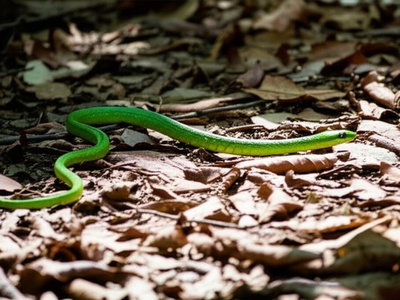
Amazon Green Racer
Active diurnal snake of Amazonian forests and clearings. Slender and green, it preys on birds, frogs, and small mammals. Rear-fanged with mild venom; bites can cause localized symptoms.

Green Rat Snake
Arboreal, glossy green snakes that feed on rodents, birds, and eggs. Non-venomous constrictors known for defensive displays and striking appearance; popular in reptile keeping for striking coloration.

Red-tailed Green Ratsnake
Distinctive green body with a reddish tail tip; arboreal and active by day. Non-venomous constrictor feeding on birds, eggs, and small mammals. Can be defensive but not dangerous to people.
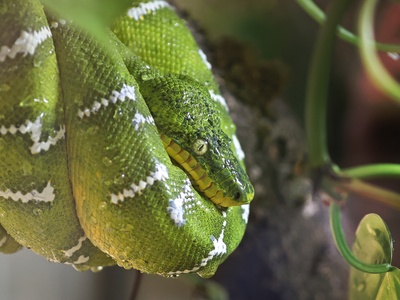
Emerald Tree Boa
Vibrant green arboreal boa with white dorsal patterning; ambush predator of birds and mammals in rainforest canopy. Non-venomous constrictor that coils on branches and rests motionless while waiting for prey.
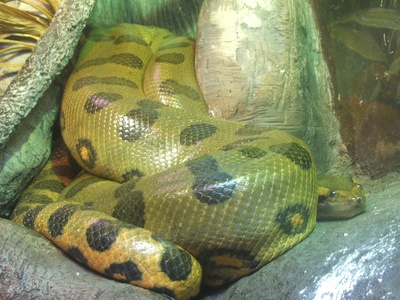
Green Anaconda
One of the heaviest snakes globally, powerful aquatic constrictor inhabiting swamps and slow rivers. Capable of taking large prey including caimans and deer. Non-venomous but potentially dangerous by size and strength.
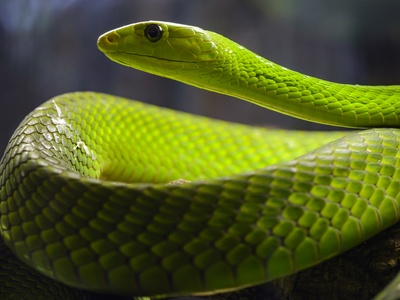
Eastern Green Mamba
Highly venomous, slender, and arboreal with vivid green coloration. Fast and nervous; bites deliver potent neurotoxic venom. Found in forests and coastal thickets; dangerous and should be avoided.
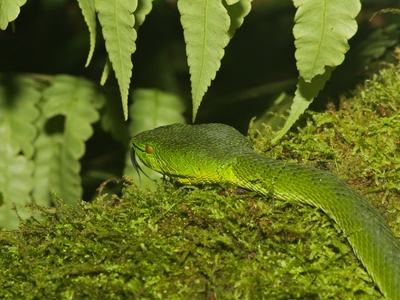
Western Green Mamba
Arboreal, intensely green mamba of forested habitats. Extremely venomous with rapid-acting neurotoxins. Avoid contact; bites are medical emergencies requiring antivenom.
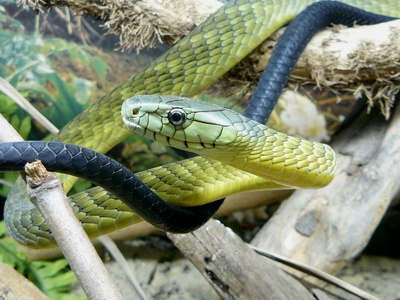
Jameson’s Mamba
Tree-dwelling mamba with variable green coloring; fast and defensive when threatened. Possesses potent neurotoxic venom. Found in forests and plantations; potentially dangerous to people.
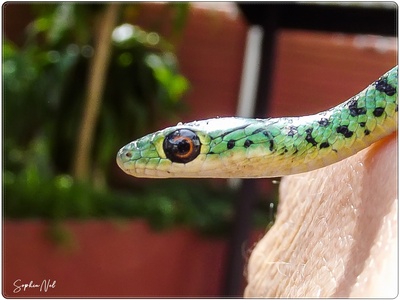
Spotted Bush Snake
Slender, green tree snake with spotted patterning; inhabits woodlands and gardens. Diurnal and insectivorous as well as eating frogs and lizards. Harmless to humans and commonly seen on bushes.
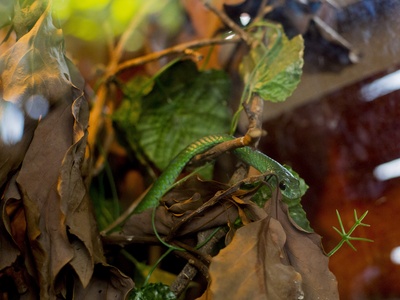
Angolan Green Snake
Green arboreal snake common in forest edges and savanna trees. Active by day, feeding on small vertebrates. Non-venomous and typically shy around people.
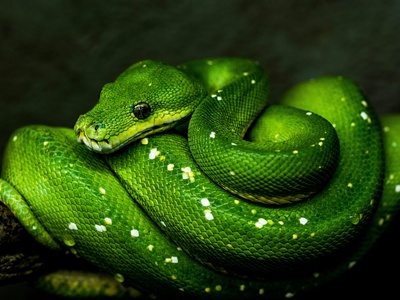
Southern Green Snake
General term for several regional green bush snakes. Diurnal, slender, and arboreal; eat frogs and lizards. Harmless to people and frequently found near water and gardens.
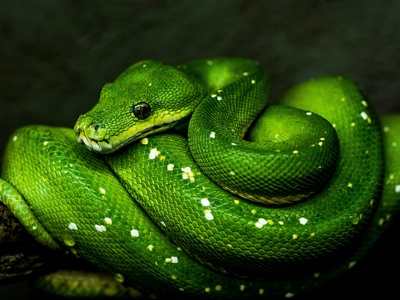
African Green Water Snake
Aquatic or semi-aquatic green snakes found in African waterways. Diet chiefly fish and amphibians; many species are non-venomous or mildly venomous. Often secretive and poorly known.
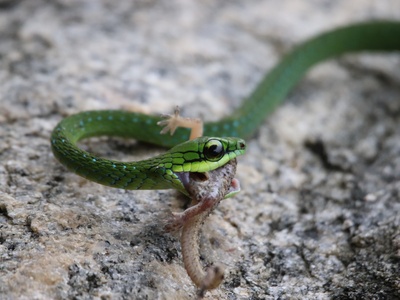
Emerald Snake
Common name for several bright-green species across regions, including tree snakes and vipers. Ecology and danger vary by species—some harmless, others venomous. See regional identification guides for specifics.
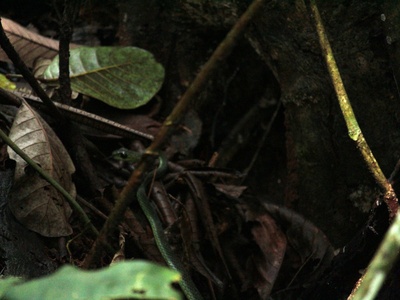
Lined Green Snake
Slim arboreal snake with green body and faint lines; diurnal and active along forest edges. Non-venomous and feeds on frogs and lizards. Good climber often seen in foliage.
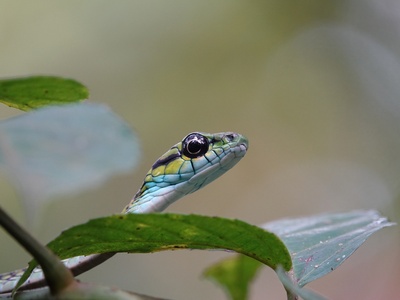
Large-eyed Green Tree Snake
Noted for relatively large eyes and slender green body; lives in trees and feeds on small vertebrates. Non-venomous and fast, relying on sight and speed to capture prey.
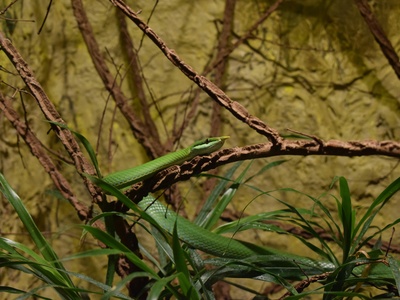
West African Green Bush Viper
Small, arboreal viper with rough keeled scales and vivid green color. Ambush predator in forest canopy; venomous and can inflict painful, medically significant bites.
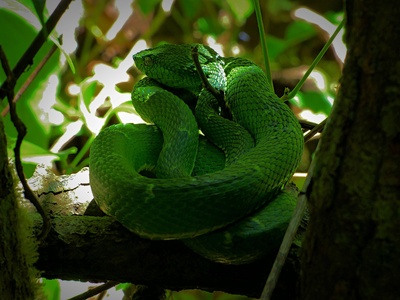
Side-striped Palm Pit Viper
A small, green palm viper with lateral stripes where present; arboreal and secretive in cloud forests. Venomous with hemotoxic effects; rarely encountered due to cryptic lifestyle.
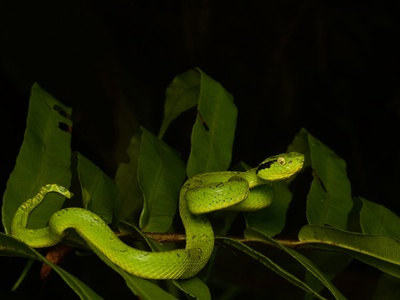
Yellow-blotched Palm Pit Viper
Arboreal green viper often marked with yellow blotches; inhabits montane forests. Venomous and ambushes small mammals and birds; caution advised when in its range.
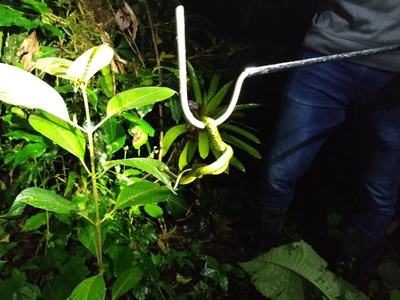
Black-speckled Palm Pit Viper
Green palm viper with dark speckling; lives in humid cloud forests and mossy forests. Venomous and well-camouflaged among epiphytes and branches.
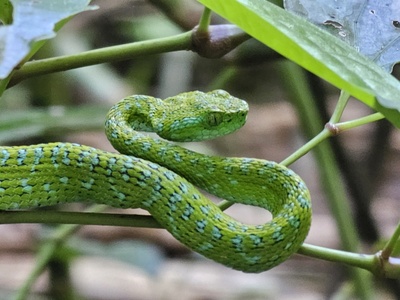
Guatemalan Palm Pit Viper
Recently described arboreal viper known from Honduran-Guatemalan highlands. Bright green with patterned markings; venomous and restricted in range, of conservation interest.
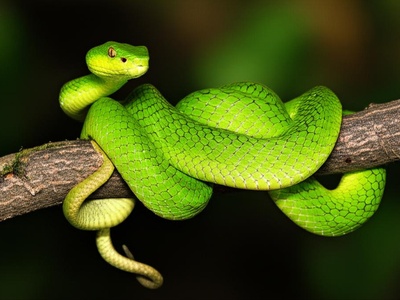
Honduran Palm Pit Viper
Group of green arboreal vipers found in Honduran cloud forests. Venomous and generally reclusive; habitat loss threatens some populations.
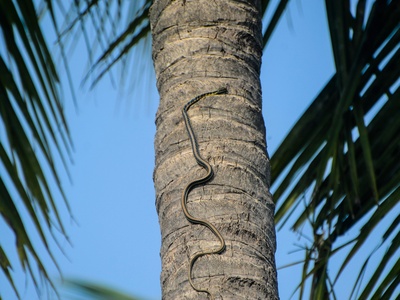
Tzotzil Palm Pit Viper
Rare, small green palm viper from mountain forests. Venomous and endemic to limited areas; distinctive and poorly known species requiring habitat protection.
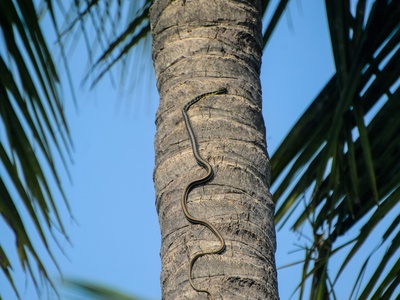
Merendon Palm Pit Viper
Montane arboreal viper with green coloration; favors humid cloud forest. Venomous and locally rare; often well-camouflaged among foliage.

Guifarro’s Palm Pit Viper
Named for Honduran herpetologist; an arboreal green pit viper from high-elevation forests. Venomous, limited range, and considered of conservation concern.
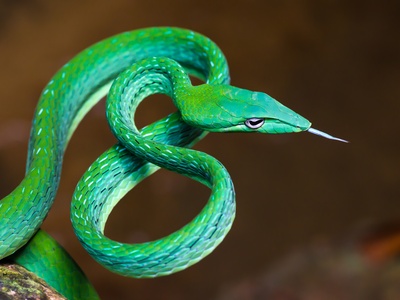
Oriental Whip Snake
Slim, green tree snake with long, whip-like body. Diurnal and excellent at camouflaging among branches, preying on frogs and lizards. Mildly venomous but not dangerous to humans.
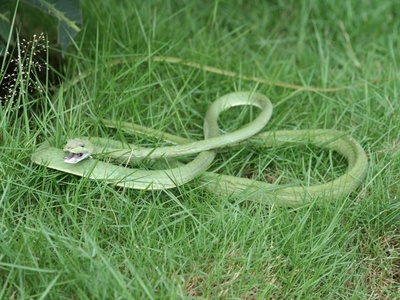
Malayan Green Whipsnake
Arboreal vine snake with pointed snout and brilliant green tones. Hunts by day and uses stealth to catch lizards and frogs. Rear-fanged with minimal human risk.
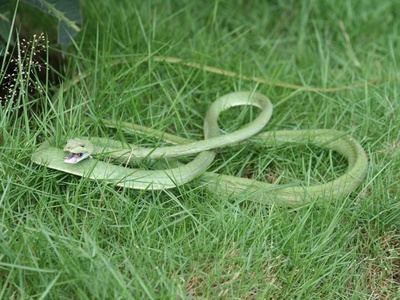
Indian Green Vine Snake
Long, thin green vine snake with distinctive pointed snout and horizontal pupils. Diurnal arboreal hunter of lizards and frogs; mild venom for prey immobilization, rarely harmful to people.
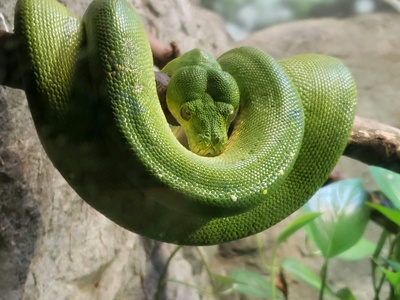
Sri Lankan Green Vine Snake
Slender, green tree snake native to Sri Lankan forests and plantations. Camouflaged and quick, it preys mainly on frogs and lizards; rear-fanged and not typically dangerous to humans.
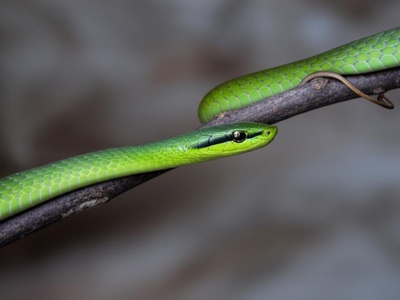
Nilgiri Vine Snake
Endemic vine snake of the Nilgiri Hills with slender body and green coloration. Arboreal and secretive, feeding on small vertebrates. Mild venom used for prey capture only.
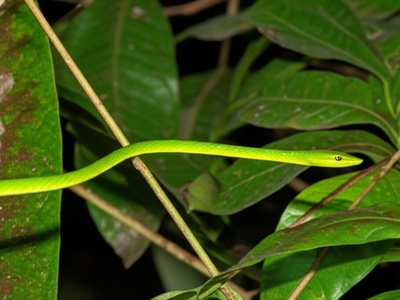
Burmese Vine Snake
Arboreal green snake of Southeast Asia with elongated form and excellent camouflage. Diurnal hunter of frogs and lizards; rear-fanged with low human risk.
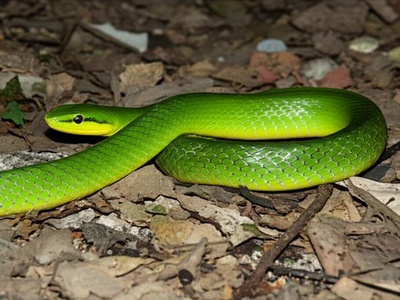
Chinese Green Ratsnake
Large, fast, non-venomous colubrid often found near water and open forests. Active predator of rodents and birds; can be defensive but not dangerous to humans.
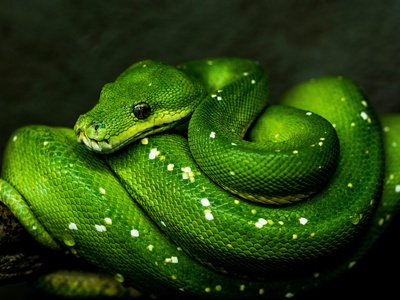
Greater Green Snake
Name applied to several large green species; typically arboreal, feeding on small vertebrates. Non-venomous in most cases; identification varies by region and species.
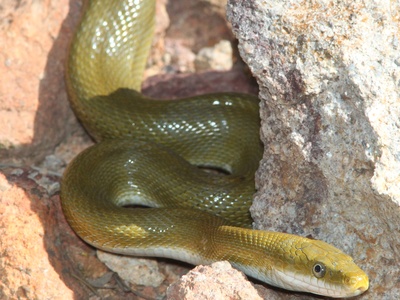
Green Ratsnake
General name for various rat snakes with green juvenile or adult phases. Non-venomous constrictors that control rodent populations and are often adaptable to edge habitats.
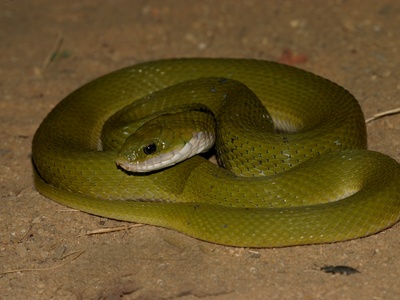
Green Keelback
Semi-aquatic snakes with green dorsal coloration; some Rhabdophis store toxins from prey and have medically significant bites. Habitats include wetlands and streams; caution advised with handling.
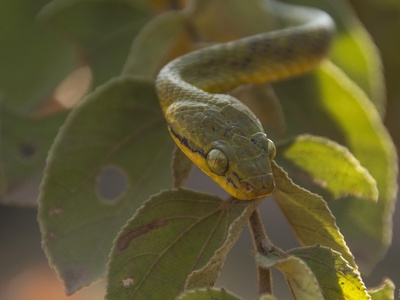
Green Cat Snake
Nocturnal arboreal snake with greenish tones; feeds on birds and lizards. Rear-fanged with mild venom; may bite defensively but usually not dangerous to healthy adults.
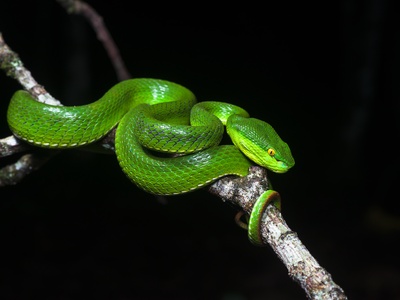
White-lipped Pit Viper
Common arboreal viper with bright green body and white upper lip line. Nocturnal ambush predator in forests and plantations; venomous and can cause significant local effects.
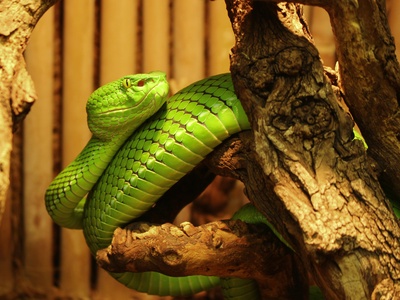
Chinese Green Pit Viper
Arboreal or semi-arboreal viper found in forests and farmland. Green coloration with variable patterning; venomous, causing pain and sometimes systemic symptoms.
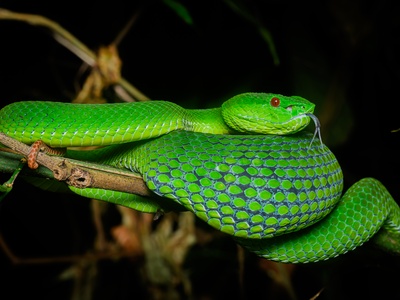
Pope’s Pit Viper
Green pit viper inhabiting forests and shrubland. Venomous and secretive; bites occur mainly when disturbed or accidentally handled.
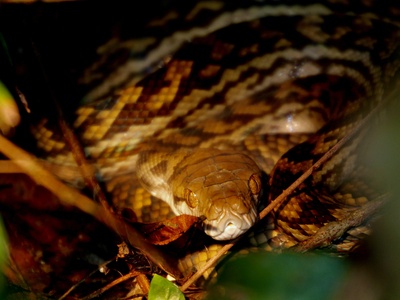
Large-eyed Pit Viper
Named for its relatively large eyes; an arboreal viper of lowland and hill forests. Venomous with medical significance and excellent camouflage among foliage.
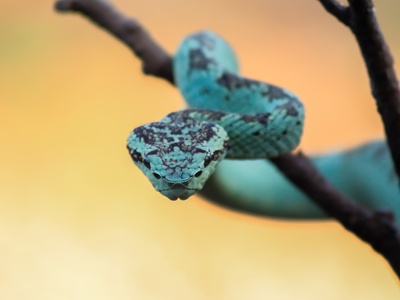
Beautiful Pit Viper
Strikingly colored green viper species endemic to limited ranges in Asia. Arboreal ambush predator; venomous and often of conservation interest due to restricted distributions.
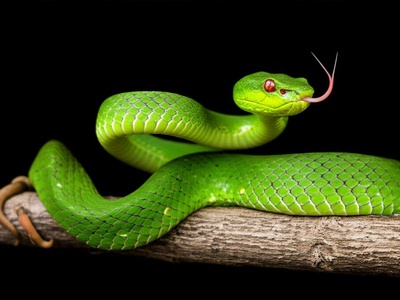
Ruby-eyed Pit Viper
Small arboreal viper notable for red or ruby eyes and green body. Inhabits lowland forests; venomous and seldom encountered but potentially dangerous.
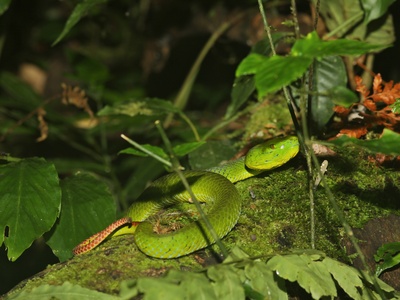
Cameron Highlands Pit Viper
Mountain-dwelling pit viper of Malaysian highlands; green with patterning. Venomous and generally nocturnal, found in montane forests and tea estates.
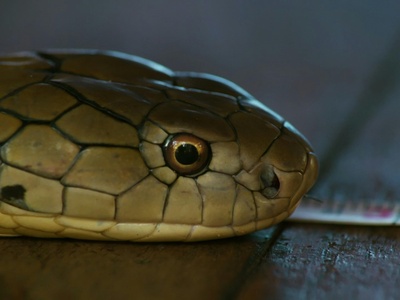
Hainan Pit Viper
Endemic green pit viper from Hainan forests. Venomous and rare, with a limited range and specific habitat needs.
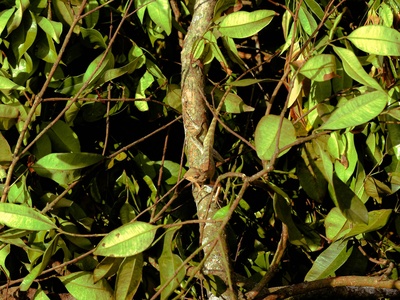
Sri Lankan Green Pit Viper
Arboreal viper native to Sri Lanka’s forests. Venomous and often camouflaged among leaves; bites can be medically significant.
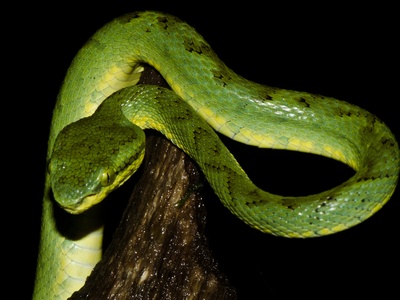
Bamboo Pit Viper
Slender green pit viper often found in bamboo groves and lowland forests. Arboreal ambush predator with potent venom; caution advised where present.
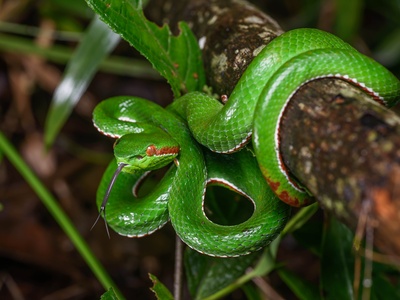
Gumprecht’s Pit Viper
Green tree viper of Southeast Asian forests; venomous and secretive, often encountered at night while hunting in vegetation.
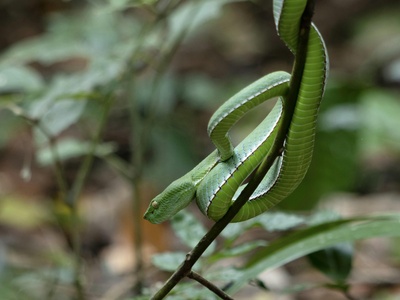
Vogel’s Pit Viper
Arboreal viper described from forested lowlands. Green coloration and cryptic habits; venomous and rarely seen by casual observers.
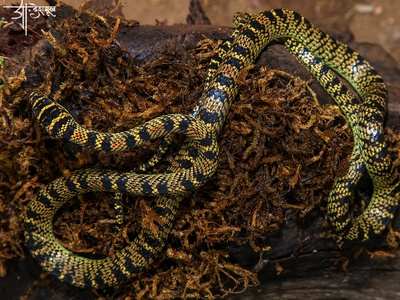
Ornate Flying Snake
Gliding tree snake capable of controlled horizontal glides between trees. Striking patterning that may include green; mildly venomous but generally not dangerous to humans.
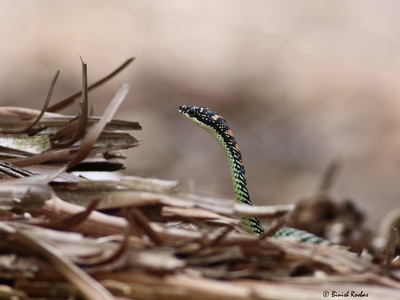
Paradise Flying Snake
Brilliantly patterned arboreal snake that glides between branches. Diurnal and agile, feeding on birds and lizards. Rear-fanged with minimal threat to people.
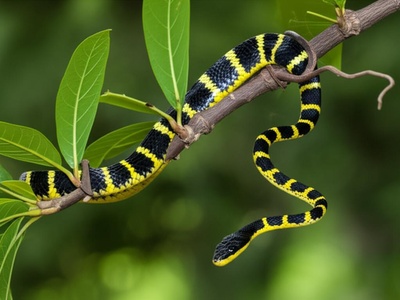
Sri Lankan Flying Snake
Endemic gliding snake of Sri Lanka with distinctive coloration. Arboreal and diurnal; glides to escape predators and ambush prey. Mildly venomous rear-fanged species.

Green Tree Python
Vivid green arboreal python that coils on branches waiting for birds and mammals. Non-venomous constrictor prized in the pet trade; juveniles often show different colors from adults.
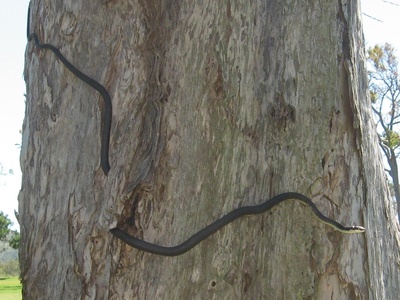
Green Tree Snake
Common name for several tree-dwelling green snakes across regions. Typically diurnal, fast-moving, and non-venomous; they feed on frogs, lizards, and small birds.
